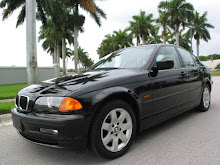
BMW has been a favorite car company of mine for many years and it is a safe assumption to say that I love all of there vehicles, well almost all of them. The BMW 5 series has been at the bottom of the barrel in terms of overall design as compared to other BMW models. Since the release of the E39 model back in 1995, my eye had never been caught by one driving down the road simply because its looks did not set it apart from other cars in its class. This isn't to say that the overall quality and performance of the vehicle was sub par to that of any other model, it was just the body style they never seemed to satisfy my taste.
The E39 model 5 series sported a similar, "aggressive," looking front as did the 3 and 7 series bimmers during the same time period but the car just looked so awkwardly long. The 7 series, BMWs largest sedan, is expected to have the elongated hood and overall body shape simply because it is the grandaddy of all the other series. Along with the never ending hood the rear end was an un-aerodynamic mess of straight lines and boxed edges complemented by over sized taillights. The look of the car had none of BMWs usual "stand-outish" styling and blended in right along with the mid size Lexus' and Mercs. The E39 was caught somewhere between the sporty 3 and luxurious 7 and never really found its place.
The next generation 5 series, the E60, had a more aggressive body style as compared to the previous model. Almost the entire body was redesigned from the headlights to the taillights! BMW scrapped the rectangular front end, found on all of its models from 95' to 04', and moved towards a more rounded aerodynamic look. The E60 with its well know "dragon eye" halo headlights and LED taillights lit up the street with its flashy looks. This model definitely was a notch above the competition on terms of looks with the tear-drop shaped headlights and the taillights creeping up the side of the car; the look was very modern but not over the top.
The E39 model 5 series sported a similar, "aggressive," looking front as did the 3 and 7 series bimmers during the same time period but the car just looked so awkwardly long. The 7 series, BMWs largest sedan, is expected to have the elongated hood and overall body shape simply because it is the grandaddy of all the other series. Along with the never ending hood the rear end was an un-aerodynamic mess of straight lines and boxed edges complemented by over sized taillights. The look of the car had none of BMWs usual "stand-outish" styling and blended in right along with the mid size Lexus' and Mercs. The E39 was caught somewhere between the sporty 3 and luxurious 7 and never really found its place.
The next generation 5 series, the E60, had a more aggressive body style as compared to the previous model. Almost the entire body was redesigned from the headlights to the taillights! BMW scrapped the rectangular front end, found on all of its models from 95' to 04', and moved towards a more rounded aerodynamic look. The E60 with its well know "dragon eye" halo headlights and LED taillights lit up the street with its flashy looks. This model definitely was a notch above the competition on terms of looks with the tear-drop shaped headlights and the taillights creeping up the side of the car; the look was very modern but not over the top.

In the past few months BMW has released snap shots of what the 2011 5 series is going to look like and I must say that I am infatuated. The car has had major reconstructive surgery all around and is donning a fantastically similar look to the current 3 series. The front end shares nearly the same look as the 3 series sedans which actually makes the new 5 look a bit leaner than it measures up to be. The rear shares a slightly modified version of the 3 series sedan's taillights with of course a bigger trunk. Overall the new look is refreshing and will not disappoint the long time 5 series followers. We can expect to see the 2011 5 series hit the market some time late next year.



















